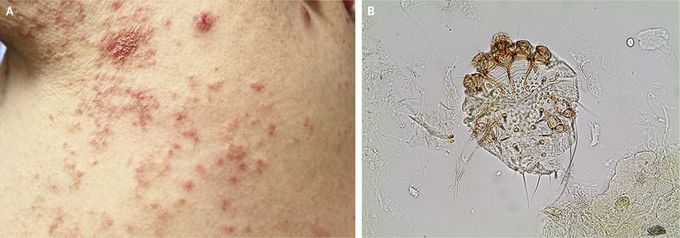


Scabies
A 61-year-old woman presented with severe pruritic rash, which had been present for 6 months. Excoriated papules with honey-colored crusting were present on the abdomen, back (Panel A), arms, and legs. Treatment with fluocinonide cream and doxycycline for suppurative folliculitis and prurigo nodularis for a period of 4 weeks produced no resolution of the rash. A biopsy of the rash revealed mixed inflammatory infiltrate with eosinophils, which was suggestive of a drug-related rash. Discontinuation of all medications resulted in no change. Finally, skin scrapings from several web spaces on the hands (scabies preparation) showed a mite under light microscopy (Panel B). Topical permethrin cream that was applied overnight to the entire body and repeated in 1 week cleared the rash within 2 weeks after the first application. Scabies is a mite-borne disease characterized by pruritus that is classically worse at night. Untreated disease can be associated with extensive eczematization of the skin owing to constant scratching. Secondary infections such as impetigo, ecthyma, paronychia, or furunculosis can also occur. Clinically, burrows are difficult to visualize and may be disguised by excoriations and impetigo. Biopsy specimens often show nonspecific changes without burrows or mites, since patients may have only 6 to 10 mites on their entire cutaneous surface.

